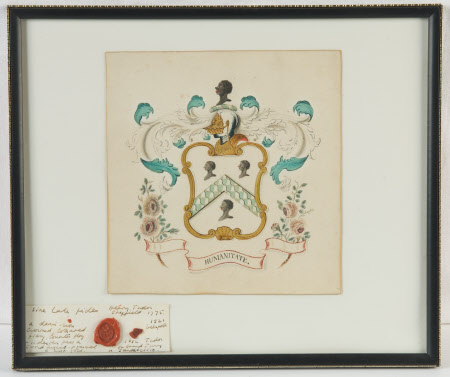Achievement of Arms of Hurlock
British (English) School
Category
Hatchments and heraldic shields
Date
1750 - 1850
Materials
Watercolour paint, ink, paper, wood, glass
Measurements
265 x 320 mm
Order this imageCollection
A La Ronde, Devon
NT 1312081
Summary
A watercolour, mounted and framed, English, last half of the 18th/first half of the 19th century. Watercolour and ink on paper, the achievement of arms of the Hurlock family, comprising the crest 'on a torse, argent and vert, a moor's head couped, in profile, proper', atop a helm amidst mantling, their coat of arms 'argent, a chevron vaire between three moors' heads couped in profile, proper', and their motto 'Humanitate.' A small piece of card to bottom left, bearing a wax seal (bearing the crest of Tudor) and an ink inscription.
Full description
Joseph Hurlock (1715-93), brother-in-law to Jane Parminter's Aunt Margaret, was governor of an East India Company colony between 1746 and 1752 and then a Director of the Company. Jane Hurlock and Sophia Hurlock successuvely owned A La Ronde between 1849 and 1879. Note on Heraldry: The head of a black person – sometimes crowned, sometimes ‘wreathed’ about the head – appears frequently as a motif (or charge) in medieval European heraldry. In the language of heraldry, the person depicted is described (or blazoned) as a ‘maure’, ‘moor’, ‘blackmoor’ or ‘blackamoor’, and the motif as ‘a maure’s head’ or ‘a moor’s head’, and so on. The term ‘maure’ derives from the Greek work ‘mauros’ meaning ‘black’ or ‘very dark’ and, in the medieval and early modern periods, was an ill-defined stereotype applied to Muslims of the Islamic Iberian Peninsula and North Africa. Usage developed to conflate Muslims of any ethnicity with black Sub-Saharan Africans. The image of the ‘moor’ or ‘blackamoor’ in European heraldry is itself usually stereotyped. Precisely when and where this motif was adopted as an heraldic charge is unknown, but the earliest example is thought to date from 11th century Italy. Its origins may lie in the invasion of Spain and Portugal in 711 by Africa and Arab Muslim forces. In Western Europe, the device may have referred to the black Egyptian St. Maurice, the patron saint of the Holy Roman Empire from the beginning of the 10th century, or to denote participation in the Crusades. Sometimes, in England, the device is used in what are known as ‘canting’ arms, and are incorporated into the arms of a family called ‘More’ or ‘More’, as a pun on their name. Several National Trust properties were, at one time in their history, owned by families whose coats of arms and/or crests incorporated ‘a moor’s head’ as an heraldic charge, and so it appears on objects which survive in National Trust collections. The arms of the Bankes family of Kingston Lacy, for instance, granted in 1613, included the crest ‘a moor’s head, full-faced, couped at the shoulders proper, on the head a cap of maintenance gules, turned up ermine, adorned with a crescent, issuant therefrom a fleur-de-lis or’. ‘Moors’ heads’ also featured in the arms of the Watt family, slave-traders and owners of several Jamaican plantations, who bought Speke Hall in 1795 and who set up their arms in stained glass in one of the windows there. The term ‘moor’ is now considered anachronistic, but it remains part of heraldry’s descriptive vocabulary. It is used here in its historical and heraldic context.
Provenance
Purchased from Mrs Tudor Perkins in 1991.
Makers and roles
British (English) School
